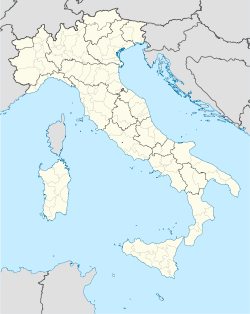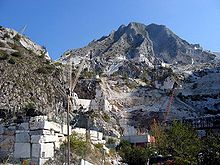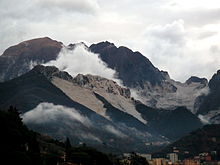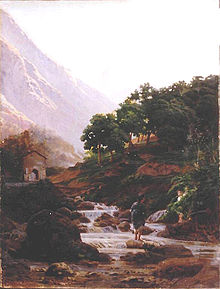- Carrara
-
Carrara — Comune — Comune di Carrara The area around Carrara, seen from an aircraft flying at 10,000 metres. The town is at the top of the picture, nearest to the marble quarries which are the white markings on the mountains. 
Coat of armsLocation of Carrara in Italy Coordinates: 44°04.75′N 10°06.00′E / 44.07917°N 10.1°ECoordinates: 44°04.75′N 10°06.00′E / 44.07917°N 10.1°E Country Italy Region Tuscany Province Massa-Carrara (MS) Frazioni Avenza, Bedizzano, Bergiola, Bonascola, Castelpoggio, Codena, Colonnata, Fontia, Fossola, Gragnana, Marina di Carrara, Miseglia, Nazzano, Noceto, Sorgnano, Torano Government – Mayor Angelo Zubbani Area – Total 71 km2 (27.4 sq mi) Elevation 100 m (328 ft) Population (31 May 2008) – Total 65,491 – Density 922.4/km2 (2,389/sq mi) Demonym Carraresi Time zone CET (UTC+1) – Summer (DST) CEST (UTC+2) Postal code 54033 Dialing code 0585 Patron saint San Ceccardo Saint day June 16 Carrara is a city and comune in the province of Massa-Carrara (Tuscany, Italy), notable for the white or blue-grey marble quarried there. It is on the Carrione River, some 100 kilometres (62 mi) west-northwest of Florence.
Its motto is Fortitudo mea in rota (Latin for "My force is in the wheel").
Contents
History
There are known settlements in the area as early as the 9th century BC, when the Apuan Ligures lived in the region. The current town originated from the borough built to house workers in the marble quarries created by the Romans after their conquest of Liguria in the early 2nd century BC. In the Middle Ages it was a Byzantine and Lombard possession, and then, it was under bishops of Luni, turning itself into an autonomous commune in the early 13th century; during the struggle between Guelphs and Ghibellines, Carrara usually belonged to the latter party. The Bishops acquired it again in 1230, their rule ending in 1313, when the city was given in succession to the Republics of Pisa, Lucca and Florence. Later it was acquired by Gian Galeazzo Visconti of Milan.
After the death of Filippo Maria Visconti of Milan in 1477, Carrara was fought over by Tommaso Campofregoso, lord of Sarzana, and again the Malaspina family, who moved here the seat of their signoria in the second half of the 16th century. Carrara and Massa formed the Duchy of Massa and Carrara from the 15th to the 19th century. Under the last Malaspina, Maria Teresa, who had married Ercole III d'Este, it became part of the Duchy of Modena.
After the short Napoleonic rule of Elisa Bonaparte, it was given back to Modena. During the unification of Italy age, Carrara was the seat of a popular revolt led by Domenico Cucchiari, and was a center of Giuseppe Mazzini's revolutionary activity.
The quarry workers, including the stone carvers, had radical beliefs that set them apart from others. Ideas from outside the city began to influence the Carrarese. Anarchism and general radicalism became part of the heritage of the stone carvers. According to a New York Times article of 1894 many violent revolutionists who had been expelled from Belgium and Switzerland went to Carrara in 1885 and founded the first anarchist group in Italy. The district in which the quarries are situated was consequently the original hotbed of anarchism in Italy. Carrara has remained a continuous 'hotbed' of anarchism in Italy, with several organizations located openly in the city. The Anarchist marble workers were also the driving force behind organising labour in the quarries and in the carving sheds.
In 1929, the municipalities of Carrara, Massa and Montignoso were merged in a single municipality, called Apuania. In 1945 the previous situation was restored.
Carrara is the birthplace of the International Federation of Anarchists (IFA), formed in 1968.
Main sights
- Cathedral (Duomo, 12th century).
- Ducal Palace (also Palazzo Cybo Malaspina, 16th century), now the seat of the Fine Arts Academy. Built over pre-existing Lombard fortification, it dates to the reign of Guglielmo Malaspina, becoming in 1448 the permanent seat of the dynasty. It includes two distinct edifices: the Castello Malaspiniano, dating to the 13th century, and the Renaissance palace, begun by Alberico I in the late 16th century. Under the medieval loggia are exposed several ancient Roman findings.
- Baroque church and convent of San Francesco, built in 1623-1664 by order of Carlo I Cybo-Malaspina.
- Church of the Suffragio, begun in 1686 under design of Innocenzo Bergamini, and refurbished in the 19th century. The façade has a large marble portal in Baroque style, sculpted by Carlo Finelli and surmounted by a bas-relief with the "Madonna and the Souls of the Purgatory".
- Palazzo Cybo-Malaspina
- Sanctuary of the Madonna delle Grazie alla Lugnola, consecrated in 1676 and designed by Alessandro Bergamini.
- Church of Santa Maria Assunta, at Torano. It has a 16th century façade with a portal from 1554. The interior is on a nave and two aisles.
Economy and culture
Carrara marble has been used since the time of Ancient Rome; the Pantheon and Trajan's Column in Rome are constructed of it. Many sculptures of the Renaissance, such as Michelangelo's David, were carved from Carrara marble. For Michelangelo at least, Carrara marble was valued above all other stone, except perhaps that of his own quarry in Pietrasanta. The Marble Arch in London and the Duomo di Siena are also made from this stone, as are the interiors of Manila Cathedral, the cold-white marbles of the Sheikh Zayed Mosque and the campus of Harvard Medical School.
The statue to Robert Burns which commands a central position in Dumfries was carved in Carrara by Italian craftsmen working to Amelia Paton Hill's model. It was unveiled by future UK Prime Minister, Archibald Primrose, 5th Earl of Rosebery on 6 April 1882.[1]
In addition to the marble quarries, the city has academies of sculpture and fine arts and a museum of statuaries and antiquities, and a yearly marble technology fair. The local marble is exported around the world, and marble from elsewhere is also fashioned and sculpted commercially here.
Derivation of name
The word "Carrara" likely comes from the ancient term "Kar" (stone). Ancient Romans quarried the marble, loaded it onto ships at the port of Luni and took it to Rome. According to Saint Girolamo, the name Carrara derives from “car” which means "wagons" and from “iara” that means "Moon", so is the “City of the Moon on the Wagons”.
Another hypothesis (Repetti) is that the term is derived from the French “careers”, which in turn is borrowed from “carrariae”, a Latin term meaning quarry. Carrara may derive from a preroman term : “kair” (Celtic) or to one from Liguria: “kar”, that means "stone" and therefore: “car+aria” meaning “place of stones”.
Politics
The Carrarese have a long tradition of independence that can be described as anarchism.
Twin towns
Carrara is twinned with:
 Yerevan, Armenia [2]
Yerevan, Armenia [2] Ingolstadt, Germany
Ingolstadt, Germany Grasse, France
Grasse, France Opole, Poland [3]
Opole, Poland [3] Novelda, Spain
Novelda, Spain Kragujevac, Serbia [4]
Kragujevac, Serbia [4]
Famous Carraresi
- Gianluigi Buffon
- Giorgio Chinaglia
- Pietro Tacca
- Cristiano Zanetti
- Domenico Bacciola
References
- ^ "National Burns Collection - Burns Statue, Dumfries with Tam O'Shanter and Souter Johnnie statues "on tour", c 1900". Burnsscotland.com. http://www.burnsscotland.com/000-000-135-599-C. Retrieved 2009-05-05.
- ^ "Yerevan Municipality - Sister Cities". © 2005-2009 www.yerevan.am. http://yerevan.am/main.php?lang=3&page_id=194. Retrieved 2009-06-22.
- ^ "Opole Official Website - Twin Towns".

 (in English and Polish) © 2007-2009 Urząd Miasta Opola. http://www.opole.pl/miasto/index.php?option=com_content&task=blogcategory&id=20&Itemid=108. Retrieved 2009-06-18.
(in English and Polish) © 2007-2009 Urząd Miasta Opola. http://www.opole.pl/miasto/index.php?option=com_content&task=blogcategory&id=20&Itemid=108. Retrieved 2009-06-18. - ^ "Kragujevac City Partners". © 2008 Information service of Kragujevac City. http://www.kragujevac.rs/en/city_partners.htm. Retrieved 2008-10-27.[dead link]
External links
- Official website
- Weather conditions at Carrara
- Marble Quarry in the Massa-Carrara region
- "Carrara" (Marble), in The Monumental News Magazine, March 1893, pp. 273-275.
- “A Marble World” (Carrara, Italy), by E. St. John Hart, article in Pearson’s Magazine, February 1903, on Stone Quarries and Beyond
- Landsat 7 photograph of Carrara marble quarries in August 2001
- Overnight in Carrara, Italy - slideshow by The New York Times
Aulla · Bagnone · Carrara · Casola in Lunigiana · Comano · Filattiera · Fivizzano · Fosdinovo · Licciana Nardi · Massa · Montignoso · Mulazzo · Podenzana · Pontremoli · Tresana · Villafranca in Lunigiana · ZeriCategories:- Cities and towns in Tuscany
- Communes of the Province of Massa-Carrara
- Carrara
Wikimedia Foundation. 2010.






